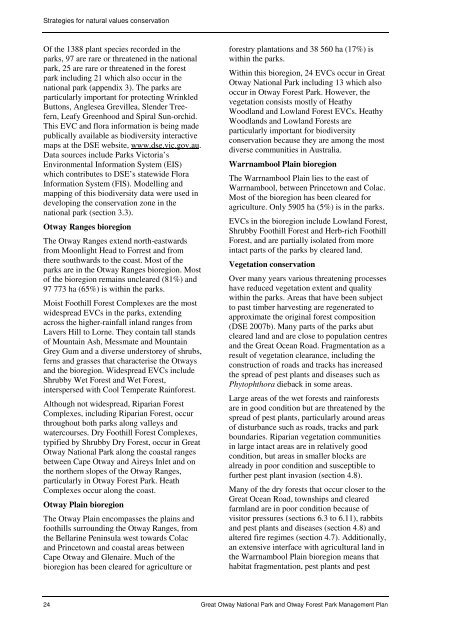Caring for Country â The Otways and You - Parks Victoria
Caring for Country â The Otways and You - Parks Victoria
Caring for Country â The Otways and You - Parks Victoria
- No tags were found...
Create successful ePaper yourself
Turn your PDF publications into a flip-book with our unique Google optimized e-Paper software.
Strategies <strong>for</strong> natural values conservationOf the 1388 plant species recorded in theparks, 97 are rare or threatened in the nationalpark, 25 are rare or threatened in the <strong>for</strong>estpark including 21 which also occur in thenational park (appendix 3). <strong>The</strong> parks areparticularly important <strong>for</strong> protecting WrinkledButtons, Anglesea Grevillea, Slender Treefern,Leafy Greenhood <strong>and</strong> Spiral Sun-orchid.This EVC <strong>and</strong> flora in<strong>for</strong>mation is being madepublically available as biodiversity interactivemaps at the DSE website, www.dse.vic.gov.au.Data sources include <strong>Parks</strong> <strong>Victoria</strong>’sEnvironmental In<strong>for</strong>mation System (EIS)which contributes to DSE’s statewide FloraIn<strong>for</strong>mation System (FIS). Modelling <strong>and</strong>mapping of this biodiversity data were used indeveloping the conservation zone in thenational park (section 3.3).Otway Ranges bioregion<strong>The</strong> Otway Ranges extend north-eastwardsfrom Moonlight Head to Forrest <strong>and</strong> fromthere southwards to the coast. Most of theparks are in the Otway Ranges bioregion. Mostof the bioregion remains uncleared (81%) <strong>and</strong>97 773 ha (65%) is within the parks.Moist Foothill Forest Complexes are the mostwidespread EVCs in the parks, extendingacross the higher-rainfall inl<strong>and</strong> ranges fromLavers Hill to Lorne. <strong>The</strong>y contain tall st<strong>and</strong>sof Mountain Ash, Messmate <strong>and</strong> MountainGrey Gum <strong>and</strong> a diverse understorey of shrubs,ferns <strong>and</strong> grasses that characterise the <strong>Otways</strong><strong>and</strong> the bioregion. Widespread EVCs includeShrubby Wet Forest <strong>and</strong> Wet Forest,interspersed with Cool Temperate Rain<strong>for</strong>est.Although not widespread, Riparian ForestComplexes, including Riparian Forest, occurthroughout both parks along valleys <strong>and</strong>watercourses. Dry Foothill Forest Complexes,typified by Shrubby Dry Forest, occur in GreatOtway National Park along the coastal rangesbetween Cape Otway <strong>and</strong> Aireys Inlet <strong>and</strong> onthe northern slopes of the Otway Ranges,particularly in Otway Forest Park. HeathComplexes occur along the coast.Otway Plain bioregion<strong>The</strong> Otway Plain encompasses the plains <strong>and</strong>foothills surrounding the Otway Ranges, fromthe Bellarine Peninsula west towards Colac<strong>and</strong> Princetown <strong>and</strong> coastal areas betweenCape Otway <strong>and</strong> Glenaire. Much of thebioregion has been cleared <strong>for</strong> agriculture or<strong>for</strong>estry plantations <strong>and</strong> 38 560 ha (17%) iswithin the parks.Within this bioregion, 24 EVCs occur in GreatOtway National Park including 13 which alsooccur in Otway Forest Park. However, thevegetation consists mostly of HeathyWoodl<strong>and</strong> <strong>and</strong> Lowl<strong>and</strong> Forest EVCs. HeathyWoodl<strong>and</strong>s <strong>and</strong> Lowl<strong>and</strong> Forests areparticularly important <strong>for</strong> biodiversityconservation because they are among the mostdiverse communities in Australia.Warrnambool Plain bioregion<strong>The</strong> Warrnambool Plain lies to the east ofWarrnambool, between Princetown <strong>and</strong> Colac.Most of the bioregion has been cleared <strong>for</strong>agriculture. Only 5905 ha (5%) is in the parks.EVCs in the bioregion include Lowl<strong>and</strong> Forest,Shrubby Foothill Forest <strong>and</strong> Herb-rich FoothillForest, <strong>and</strong> are partially isolated from moreintact parts of the parks by cleared l<strong>and</strong>.Vegetation conservationOver many years various threatening processeshave reduced vegetation extent <strong>and</strong> qualitywithin the parks. Areas that have been subjectto past timber harvesting are regenerated toapproximate the original <strong>for</strong>est composition(DSE 2007b). Many parts of the parks abutcleared l<strong>and</strong> <strong>and</strong> are close to population centres<strong>and</strong> the Great Ocean Road. Fragmentation as aresult of vegetation clearance, including theconstruction of roads <strong>and</strong> tracks has increasedthe spread of pest plants <strong>and</strong> diseases such asPhytophthora dieback in some areas.Large areas of the wet <strong>for</strong>ests <strong>and</strong> rain<strong>for</strong>estsare in good condition but are threatened by thespread of pest plants, particularly around areasof disturbance such as roads, tracks <strong>and</strong> parkboundaries. Riparian vegetation communitiesin large intact areas are in relatively goodcondition, but areas in smaller blocks arealready in poor condition <strong>and</strong> susceptible tofurther pest plant invasion (section 4.8).Many of the dry <strong>for</strong>ests that occur closer to theGreat Ocean Road, townships <strong>and</strong> clearedfarml<strong>and</strong> are in poor condition because ofvisitor pressures (sections 6.3 to 6.11), rabbits<strong>and</strong> pest plants <strong>and</strong> diseases (section 4.8) <strong>and</strong>altered fire regimes (section 4.7). Additionally,an extensive interface with agricultural l<strong>and</strong> inthe Warrnambool Plain bioregion means thathabitat fragmentation, pest plants <strong>and</strong> pest24 Great Otway National Park <strong>and</strong> Otway Forest Park Management Plan

















